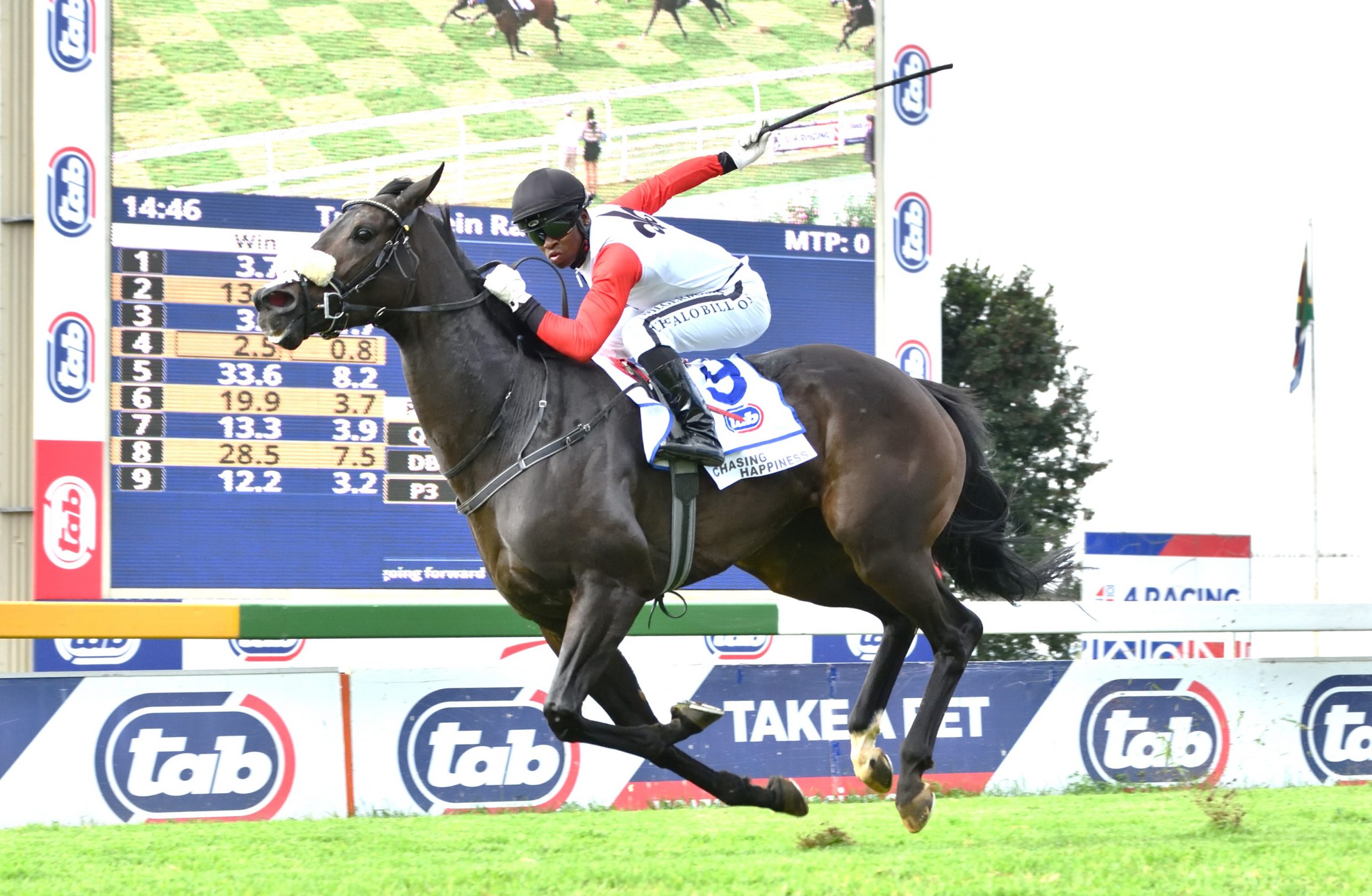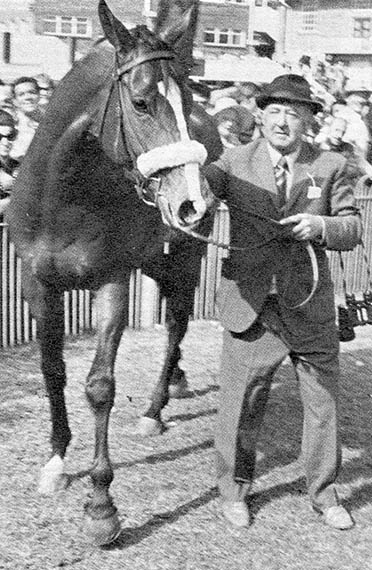
Sentinel & Joe Joseph
The Cape Flying Championship was introduced as a test of sheer speed over the fast Milnerton 1000m course and run for the first time in 1969 for a stake of R4000. Forty five years later it has grown into a prestigious Gr1 run for a stake of R1 million and boasts some of the great flyers of recent years on its illustrious honour roll.
The race was switched to Kenilworth for obvious reasons from 1996 and the brilliant Eric Sands trained Flobayou thus holds the distinction of being the only horse to win the sprint at both Milnerton and Kenilworth. Theo De Klerk trained the very first winner Benzol for his wife Lavinia.
In spite of meeting most of the field on worse terms than he would have done in a handicap, Benzol was made favourite. He raced to the front under Robbie Siveweright and was never headed, holding off a strong challenge from Tantivy by a neck, with Fire Eyes a length back third and Madras, in the same colours, fourth. From those fairly humble beginnings, the race has evolved into a serious test of speed and some of our biggest speed names have won it multiple times.
The biggest of those is the ‘Iron Horse’ Sentinel, who won the race for three years in succession from 1973. Other multiple winners are Free Enterprise, Signor Amigo, Flobayou, Cordocelli, Laisserfaire, Nhlavini and What A Winter. The brilliant Jet Master won the race in 2000 and his son Divine Jet looks to emulate his champion Dad when he goes for his personal first Gr1 win. Dean Kannemeyer saddles him on Saturday for his L’Ormarins Queen’s Plate winning connections, Khaya Stables.
The supporters of the flying fillies Via Africa and Victorian Secret on Saturday will be interested to know that the fairer sex also have a fair record in the race. Alec Soteriadis trained the Scott Brothers bred Leta under John Garcia to win in 1970. It was to be eleven years before the fillies would strike again. Mike Bass’ brilliant Sweet Chestnut won the race in 1981. Glen Kotzen sent out Nobely Born in 1997 and then the Snaith’s outstanding Australian bred Laisserfaire registered her double in 2001 and 2002.
Sentinel: A Golden Hat Trick
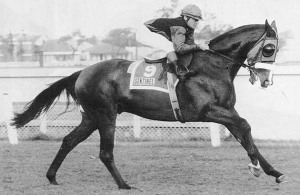
Sentinel
The Cape Flying Championship’s greatest winner and dubbed ‘The Iron Horse’ because of his tough and enduring character, Sentinel stands tall. His statistics tell the story of resilience, bravery and versatility. From 56 starts, he recorded 29 wins – with 12 Grade 1s and 21 places. Racing from two to seven years of age between 1971 and 1975, he travelled throughout the country and won at eight different racecourses from 1000m to 1600m. There has been no other South African horse with a record like that at the top level.
The 1975 Jack Stubbs Memorial (then the name of the Cape Flying Championship) over 1000m at Milnerton is remembered by many as the cherry atop a fabulous career for Sentinel. On a perfect Cape summer day, seven-year-old Sentinel whipped talented speedster Harry Hotspur, with two other precocious youngsters way back in third and fourth -Archangel and Yataghan.
“He was a real toughie, that’s what I remember most about him. A phenomenally strong horse,” says Michael (Muis) Roberts, the jockey who partnered Sentinel to many of his successes. “He was massive, at least 17 hands, and weighed about 600kg.” Sentinel was bred by the Ellis family on their Mooi River farm, Hartford, which is now part of the estate of South African champion stud Summerhill. Ray Ellis had started breeding and racing horses in 1940and moved quickly into the top rank of the South African turf with horses like Cape Heath, Panjandrum,Ajax, Magic Mirror and the great Mowgli.
When Sentinel went into training as a two-year-old in 1970, he joined another beginner in the game, a tiny apprentice jockey nicknamed Muis. The latter remembers riding the horse in work for Joe Joseph, trainer to Ray Ellis and his son Graham. “He showed huge promise right from the beginning,” recalls Roberts. “But his first race, in which he was ridden by George Davies, was very poor and he finished way back. I galloped him a few days later and couldn’t believe this horse hadn’t won by miles. But it was a different story in his second race, and for a few years after that!”
As a juvenile, the colt shed his maiden tag over 1000m at Clairwood, then won the 1400m Natal Breeders Stakes and the 1200m African Breeders Plate. He finished second in the Grade 2 Smirnoff Plate at Scottsville and fourth in the Grade 1 Champion Nursery.
Davies was in the irons for all the early wins, but Roberts increasingly got the nod from Joseph as the young rider’s talents emerged. “Maybe Uncle Joe thought I wasn’t strong enough to start with. He was such a massive horse, I must have looked like a pimple on him,” says Muis. The future South African and British champion jockey’s big chance came in 1972 after Sentinel turned three. Muis particularly remembers the Christmas Handicap at Clairwood, a prelude to a planned Cape Town campaign.
“He was completely un-extended. I never moved a muscle on him and he cruised in.” In Cape Town for the summer season, In Full Flight prevailed over Sentinel by a short head in the1400m Swazi Spa Stakes, setting the scene for a showdown that is still talked about today in awed tones.
The publication “Thoroughbred News” described the 1972 Cape Guineas: “The sharp Milnerton 1600m was the mile that suited Sentinel. In Full Flight came for him, and Sentinel was ready. They turned for home even, and they stayed that way. First the blaze was in front, then In Full Flight held a narrow advantage. Whips flashed, sides heaved, heads nodded, and neither great horse gave an inch. At the line no-one could separate them and the judges put up a dead heat.”
One of the few people not bowled over by this momentous result was Muis, who reckons his horse actually won. “Sentinel’s white blaze cost him the race. The line on the photo finish picture covered the very tip of his nose, which was ahead. That’s what I believe anyway!” he laughs.
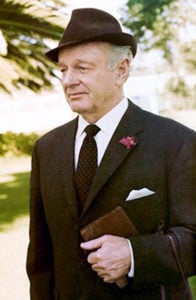
Theo de Klerk
Next up was the Queen’s Plate over the Kenilworth 1600m, a trip that was to prove to be at Sentinel’s limit. In Full Flight stayed better to take it. Back in Durban, Sentinel gave weight and a beating to Elevation in the 1200m Rupert Ellis Brown Memorial.
It had become clear that Sentinel was the supreme sprinter-miler and his two great adversaries were more in the miler-stayer mould – confirmed by In Full Flight winning the Durban July before his premature death and Elevation landing a Holiday Inns (Summer Cup) treble.
As for Sentinel, he went on to dominate the shorter features year after year, eventually becoming the country’s leading stakes earner with the princely sum of R207,390.
As a three-year-old he won eight times in 15 starts, at four it was another eight wins, at five two wins, at six three wins and at seven five wins. No sprint in the country was safe. The Cape Flying Championship, the Drill Hall Stakes, the Newbury, the Concord and the Woolavington Cup were some of the titles he accumulated.
Joseph and the Ellis’ weren’t averse to trekking to unfashionable Port Elizabeth to plunder more honours. The July 1974 “The South African Racehorse” reported: “Never in the 117-year history of racing at Fairview has a single horse attracted so much money and so many people as did Sentinel in the R10,000 Fairview Stakes over 1600m. A field of 13 took on the champion but they had as much chance of beating Sentinel as a drop of water had of surviving a bush fire.”
Jet Master: Millenium Man
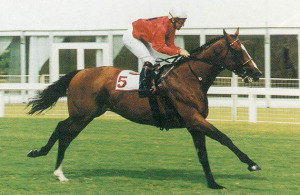
Jet Master – 2000 Gr1 Cape Flying Championship
The ill fated longstanding SA Champion sire Jet Master was the undisputed king among the milers, but used the 2000 Cape Flying Championship to prove that, given the right programme, he could also have been one of our greatest sprinters.
Owned by Henry and Pat Devine, the huge entire had continued to blossom after switching from the care of Tony Millard to Geoff Woodruff. He certainly had nothing left to prove after winning the Queen’s Plate for the second year in succession – sandwiching the brace with a win in the Nissan Challenge and putting his supremacy over a mile beyond any reasonable doubt.
Facing an assembly of the Cape’s best sprinters, Jet Master started at 7-10 for the 2000 Cape Flying Championship but even so lifted eyebrows in the grandstand as he took them on at their own game, speed – and proceeded to blow them right out of the park.
Dominion Ruler, as usual, showed incredible early toe, powering about four lengths clear of the pack into a strong headwind. However, few could believe it as Jet Master’s bright orange livery came out to race a clear second with the rest tightly packed in a neat group two lengths back with Cordocelli bringing up the rear. Dominion Ruler “ran out of gas” coming off the false rail, allowing Jet Master to inherit the lead and everyone inched forward on their seats as the pack started organising themselves.
Anton Marcus, who got on so well with JM, had read the race and the amount of horse he had under him superbly. Giving the signal one could sense his delight as Jet Master took off again, coasting home five lengths clear of a very dejected-looking pack. Cordocelli, bidding for his third successive win in this race, underlined his class by flying up from the tail of the field to snatch second from ultra-consistent Ghostly galleon and Eli’s Game.
Jet Master had put on 8kgs since his win in the Queen’s Plate. Asked to explain, Woodruff said at the time: “Perhaps it is the heavier tracks here that bulked him up a bit more. I must say, looking at him in the parade ring I thought he actually looked a little more trimmed down! We did not ease up on his work.”
“I want to thank the Devines for the opportunity to ride Jet Master,” said Anton Marcus afterwards. Anyone could have sat on him today and won. You know it is a real privilege to ride a horse like this and I am eternally grateful to them. We knew he had the speed to get to the front and that was our plan. But we never knew how long he would be able to stay there. I must say Dominion Ruler was really too fast for us, but he was always going to come back to us.”
Cordocelli: 1998 & 1999
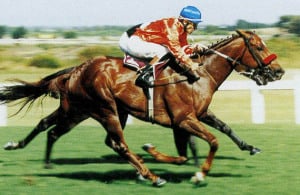
Cordocelli – 1999 Gr1 Cape Flying Championship
While lacking the brilliance of some of the big names to win this race, the very quick Cordocelli was trained by Chris Snaith to win the Cape Flying Championship for two years in a row. Coming off a poor effort in the Natal Mercury Sprint, where he had bled, Cordocelli proved that it pays to persevere with a good horse.
“He doesn’t bleed in Cape Town,” explained Justin Snaith at the time. “But he had bled so badly in Durban I suspect he lost his confidence. Horses are reluctant after an experience like that to race flat-out. They are afraid it will happen again.” As a result Cordocelli’s form had looked lacklustre coming into the 1999 race. He was out to emulate his arch-rival Flobayou who had won the race in 1995 and 1996, and gone second to Glen Kotzen’s smart mare Nobely Born in 1997.
Flobayou was not there this time to shout his sparring partner home as he had been retired, and was headed for the show ring, possibly jumping if his no-nonsense attitude would tolerate it. The Snaith team had done their homework and Cordocelli came into the ring looking stripped, confident and a picture of well-being. Garth Puller was given the reins and the evergreen veteran excelled after things had not run their way during the race.
The Cordocelli connections were no doubt heartened as the stalls opened and Flashy Star and Golden Khaya set about one another in earnest, as 1000m is on the sharp side for Cordocelli and he needs a cracker-pace to produce his best. Even the quick filly Raise The Ransom was having problems staying in touch with Okukama, Clariano and Ghostly Galleon leading out Cordocelli and the favourite Runaway Brave.
Flashy Star had a two-length lead as they left the false rail, and Jeff Lloyd had clearly timed his run perfectly as he produced Runaway Brave down the inside for his final effort. Cordocelli, however, was the victim of some close-order racing and Puller had to duck and dive to find a gap. He managed, in typical fashion, squeezing Cordocelli through – only to find Runaway Brave in full cry for the “line”.
However, Puller on the right horse in such situations is a treat to watch and Cordocelli, ears flattened, visibly warmed to the task. Ranging at Runaway Brave’s quarters just as that one despatched Flashy Star, the chestnut tightened the noose stride by stride. A 1000m specialist at this level, Runaway Brave was feeling the brunt of the stiff headwind and just couldn’t find an extra gear to fight him off. Cordocelli surged up late to snatch a well-deserved and popular win. Trainer Chris Snaith, normally reserved in the focus of a camera, was stirred up enough to warn that Cordocelli would be back the following year to make it a treble!








